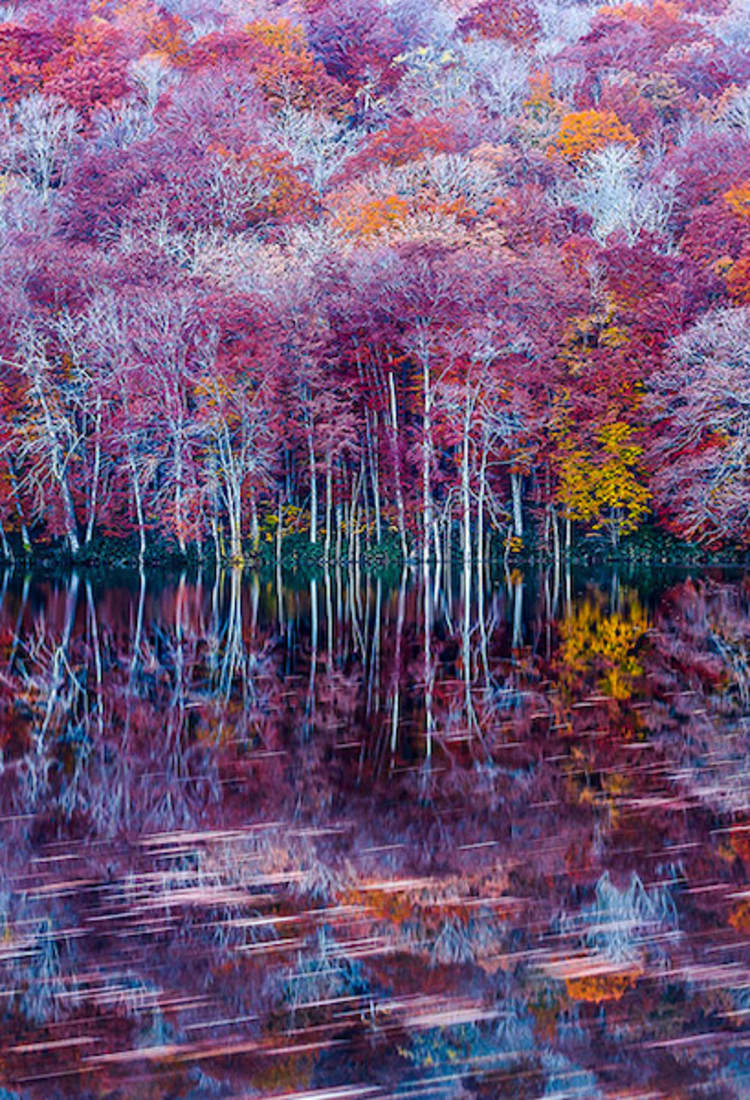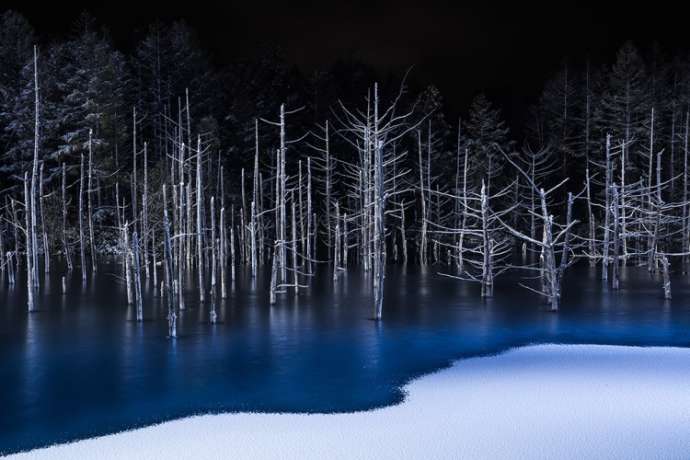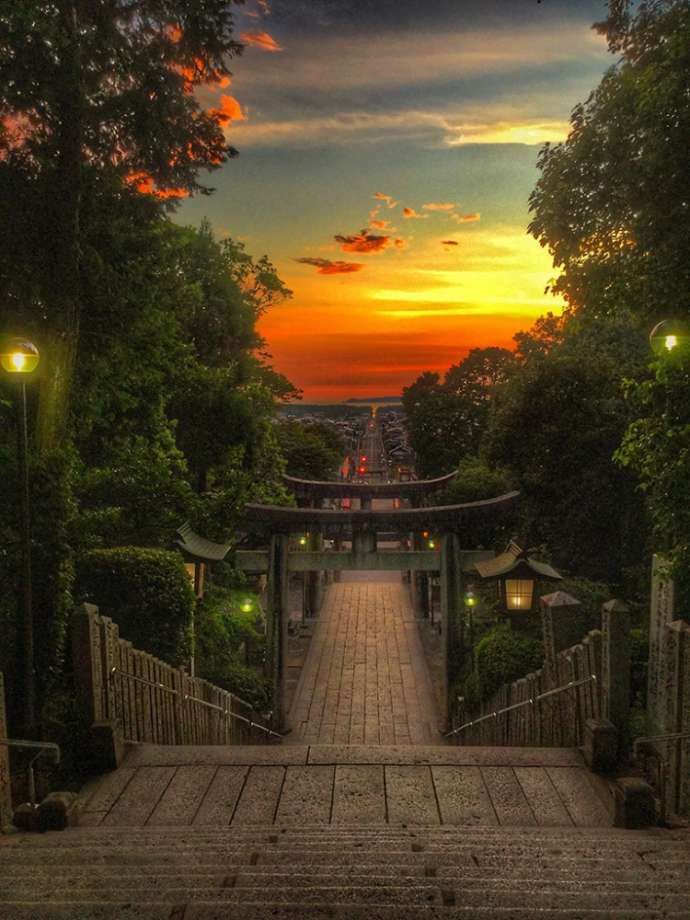
Useful tips and techniques for shooting beautiful landscapes of Japan
Useful tips and techniques for shooting beautiful landscapes of Japan
Shirakawa-go – Gifu-
Designated as a Unesco World Heritage Site, Shirakawa-go in Gifu Prefecture is one of the most intriguing villages in Japan. The steep thatched roof houses are a wonderful subject for photography especially on snowy nights. These houses with 300 years of history are still used as homes, hotels, and museums.

Photography Tips
This photo was taken from the Shirakawago observation deck from where you’ll have an entire view of the village. I contracted the aperture (above f/8) for a pan-focus effect. A tripod was used to avoid blurring.
Best Time for Photos
For fire prevention, a large fire drill is held in Shirakawago at the beginning of November. (As it is for training purposes only, the exact date and time are not publicly announced.)

Photography Tips
This photo was taken from the Shirakawago observation deck from where you’ll have an entire view of the village. I contracted the aperture (above f/8) for a pan-focus effect. A tripod was used to avoid blurring.
Best Time for Photos
For snowfall during the winter season, the best time is late December to February. To capture the warm atmosphere of the settlement at night, I recommend shooting when the houses are lit after sunset. 6 p.m. to 8 p.m. is the best for photographs as most houses turn off their lights after 9 p.m.

Photography Tips
For this photo, I used a strobe to capture the snow bokeh. Because built-in flash may not be enough, I recommend using a clip-on strobe.The focus is on the thatch-roofed house. When the aperture is opened, the snow bokeh comes out beautifully large and soft.
Best Time for Photos
For snowfall during the winter season, the best time is late December to February. To capture the warm atmosphere of the settlement at night, I recommend shooting when the houses are lit after sunset. 6 p.m. to 8 p.m. is the best for photographs as most houses turn off their lights after 9 p.m.
Photo & text : Atsushi Kobayashi
What You Need to Know
Be careful not to disturb other people because the observation deck is a popular spot. Tripods are forbidden at certain times, such as during lighting events. Please keep by the rules so that everyone can enjoy this beautiful spot. It is strictly prohibited to trespass the rice terraces as they are private property. The same goes to farm roads. If the road is private property, please obtain permission from the owner before taking photos.
|
How to Get There |
|
Getting There by Bus ・Approximately 2-hours and 50-minutes on the Highway Bus Shirakawa-go Line from JR Nagoya Station. ・Approximately 50-minutes on the Shirakawago Line, Takayama-Shirakawago/Kanazawa Line, Takayama-Shirakawago/Toyama Line from JR Takayama Station. ・Approximately 2-hours and 10-minutes on the World Heritage Bus (bound for Gokayama Shirakawa-go) from JR Takaoka Station. ・Approximately 1-hour and 15-minutes on the Takayama-Shirakawago/Kanazawa Line from JR Kanazawa Station. ・Approximately 1-hour and 25-minutes on the Takayama-Shirakawago/Toyama Line from JR Toyama Station. Getting There by Car ・Approximately 4.5km from Shirakawago Interchange on the Tokai-Hokuriku Expressway. |
Blue Pond -Hokkaido-
A fascinating pond with beautiful blue surface. The withered Japanese larch trees also take part in creating the magical atmosphere of the Blue Pond.



Photography Tips
When capturing the entire scene in the composition, a focal length of about 20mm-50mm is recommended. When focusing on the center of the pond as in this photo, the optimal focal length is about 70mm-100mm.
Best Time for Photos
You can shoot throughout the year, but when trying to capture scenes with withered reeds reflecting on the pond surface, the earlier in the morning the better because the pond does not ripple in early mornings (excluding the winter season, when the pond is frozen).
Photo & text : Hiroshi Tanita
What You Need to Know
Because the passage around the pond is narrow, please be careful of people passing behind you when using a tripod.
|
How to Get There |
|
Getting There by Bus ・Get off at JR Biei Station on the Furano Bus Lavender-Bus from Asahikawa Airport.The Blue Pond is approximately 20-minutes on the Dohoku Bus from JR Biei Station. Getting There by Car ・Approximately 40-minutes from Asahikawa Airport. ・Approximately 20-minutes from JR Biei Station. |
Reflection Beach – Ibaraki-
The Reflection Beach in Oarai, Ibaraki Prefecture, is a vast gently sloping beach. As the tide ebbs from high to low, and the fine beach sand slowly absorbs the sea water, a thin layer of water spreads over the beach creating a gorgeous reflection.


Photography Tips
What’s special about this spot is that anyone can capture a gorgeous reflection, even with a mobile phone. Enjoy taking pictures with accessories, or try taking a photo together with your friends jumping in the air.
Best Time for Photos
You can take photos everyday at different times, and shoot various scenes with the sun at different positions.
Photo & text : CHIKAKO YAGI
What You Need to Know
During the summer, the beach is open to the public for swimming, so photos can be taken only during the spring, autumn, and winter. The beach is vast and you may use tripods for shooting, but please be careful not to get in the way of other visitors. You also need to be careful not to get hit by the large waves that come in occasionally. Especially, in bad weather, the sea can get rough and it will become very dangerous. Please also be careful not to get injured from seashells buried in the sand when jumping around in bare feet.The site features a large parking lot, so you won’t have trouble finding a spot to park your car. You can keep your valuables at Oarai Sun Beach Tsunami Evacuation Facility at 500 yen per day for one box.
|
How to Get There |
|
Getting There by Train ・Get off at Oarai Station on the Kashima Rinkai Railway Oarai Kashima Line from Mito Station. The Reflection Beach is a 15-minute walk from Oarai Station. Getting There by Car ・Approximately 6.3km from Mito-Oarai Interchange of Kita-Kanto Expressway. |
Tsutanuma – Aomori-
Towada-Hachimantai National Park in Aomori Prefecture is dotted with lakes called the “Tsutanananuma”. “Tsutanuma” is the largest of the seven lakes, and the closest and easily accessible from the parking lot.


Photography Tips
Capturing the entire scene in the composition using a wide angle is nice, but early mornings in autumn are a popular time, so you may get people in the photo whether or not that is your aim. By skillfully capturing the shadows and the areas lit by sunlight using a medium telephoto lens, you can emphasize the liveliness of the reflection produced by the contrast.
Best Time for Photos
Tsutanuma has recently become a popular photo spot, autumn being the most popular of the four seasons. Early morning is the be best for shooting. The morning sunlight further redden the hardwood forests with their broad leaves dyed in autumnal colors, creating a symmetrical reflection on the water surface. Because the reflections on the lake surface are what makes this place special, conditions of strong wind or rain are not optimal.
Photo & text : Akifumi Homma
What You Need to Know
In recent years, this spot has become a popular photography spot especially during the autumn foliage season. When shooting an early sunrise, it is recommended to arrive in the middle of the night to be sure you get a place.
|
How to Get There |
|
Getting There by Train ・Get off at Tsuta Onsen Station on the JR Mizuumi Train from Shin-Aomori Station.Tsudanuma is a 5-minute walk from Tsuta Onsen Station. Getting There by Car ・Approximately 58km toward Hakkoda on National Route 103 via Prefectural Road No.2 from Kosaka Interchange on the Tohoku Expressway. |
Miyajidake Shrine -Fukuoka-
Stretching straight from the sea to Miyajidake Shrine is the approach known as the “Road of Light”. Here, the sun sets right ahead of the road for a limited time in October and February.

Photography Tips
As a composition, it is better to take the stairs facing the sea from the top of the path leading up to the shrine so that the left and right sides appear symmetrically balanced. Further, to better picture the approach path, portrait orientation is recommended. Since you will not need high shutter speeds, you can take pictures without a tripod. (Tripods are prohibited on the stone stairway of the approach path.)
Best Time for Photos
The evening sun illuminates the path approaching Miyajimake Shrine from mid to late October and from mid to late February. Shooting is recommended from around 5 p.m., about 30 minutes before sunset.
Photo & text : yoshi19860227

Photography Tips
Shoot from the top of the stone stairway (shrine side) in portrait orientation so that the entire approach path extending to the coast enters the frame. Set the aperture to about f/5 to f/10. Exposure should be between ISO 500 and 1000. Not much exposure is needed given the strong backlighting before sunset. To give it a warm accent, increase the color temperature at the time of shooting.
Best Time for Photos
The evening sun illuminates the path approaching Miyajimake Shrine from mid to late October and from mid to late February. Shooting is recommended from around 5 p.m., about 30 minutes before sunset.
Photo & text : Masataka Nishikawa
What You Need to Know
Because tripods are prohibited on stone steps approaching the shrine, shooting will be hand-held. Please be careful not to make too much noise while shooting, as there are shops and private residences on both sides of the approach path. Also, many visitors come to pay respects to the shrine rather than for shooting purposes. Please be careful not to block their way.
|
How to Get There |
|
Getting There by Public Transportation ・Get off at JR Fukuma Station on the Kagoshima Main Line from JR Hakata Station. Miyajidake Shrine is a 5-minute bus/taxi ride or 25-minute walk from JR Fukuma Station. Getting There by Car ・Approximately 10km from Koga Interchange on the Kyushu Expressway. ・Approximately 23km from Wakamiya Interchange on the Kyushu Expressway. |




















































